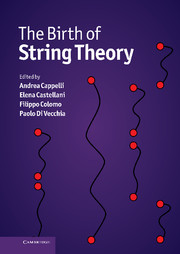Book contents
- Frontmatter
- Contents
- List of contributors
- Photographs of contributors
- Preface
- Abbreviations and acronyms
- Part I Overview
- EARLY STRING THEORY
- Part II The prehistory: the analytic S-matrix
- Part III The Dual Resonance Model
- Part IV The string
- TOWARDS MODERN STRING THEORY
- Part V Beyond the bosonic string
- 27 Introduction to Part V
- 28 From dual fermion to superstring
- 29 Dual model with fermions: memoirs of an early string theorist
- 30 Personal recollections
- 31 Aspects of fermionic dual models
- 32 The dual quark models
- 33 Remembering the dawn of relativistic strings
- 34 Early string theory in Cambridge: personal recollections
- Part VI The superstring
- Part VII Preparing the string renaissance
- Appendix A Theoretical tools of the Sixties
- Appendix B The Veneziano amplitude
- Appendix C From the string action to the Dual Resonance Model
- Appendix D World-sheet and target-space supersymmetry
- Appendix E The field theory limit
- Index
31 - Aspects of fermionic dual models
from Part V - Beyond the bosonic string
Published online by Cambridge University Press: 05 May 2012
- Frontmatter
- Contents
- List of contributors
- Photographs of contributors
- Preface
- Abbreviations and acronyms
- Part I Overview
- EARLY STRING THEORY
- Part II The prehistory: the analytic S-matrix
- Part III The Dual Resonance Model
- Part IV The string
- TOWARDS MODERN STRING THEORY
- Part V Beyond the bosonic string
- 27 Introduction to Part V
- 28 From dual fermion to superstring
- 29 Dual model with fermions: memoirs of an early string theorist
- 30 Personal recollections
- 31 Aspects of fermionic dual models
- 32 The dual quark models
- 33 Remembering the dawn of relativistic strings
- 34 Early string theory in Cambridge: personal recollections
- Part VI The superstring
- Part VII Preparing the string renaissance
- Appendix A Theoretical tools of the Sixties
- Appendix B The Veneziano amplitude
- Appendix C From the string action to the Dual Resonance Model
- Appendix D World-sheet and target-space supersymmetry
- Appendix E The field theory limit
- Index
Summary
Student in Cambridge
After all this time I do not trust my memory to be accurate in every detail. Besides, I can only provide glimpses from the perspective of a beginning graduate student struggling to catch up, followed by that of a postdoc who found himself quite far from much of the action. I will not attempt to be comprehensive in either the telling or the references, rather I will restrict myself to those aspects I concentrated on at the time, some of the people I knew and who influenced me, and will try not to add any insights that have emerged over subsequent years.
In October 1969, more than forty years ago, I started my three years as a graduate student in the Department of Applied Mathematics and Theoretical Physics, Cambridge. During the previous year, as was customary then, I took Part III of the Mathematics Tripos. This was a thorough grounding in many of the tools then useful in elementary particle theory. However, by today's standards it was lacking in some respects, especially in the area of quantum field theory – the most notable omission being any mention of Yang–Mills gauge theory. This was hardly surprising, of course, because most of the Cambridge group had been actively developing S-matrix theory and ‘Eden, Landshoff, Olive and Polkinghorne’ wasmandatory reading for prospective graduate students. Less surprising, was the omission of any reference to the Veneziano model, it being far too much of a recent innovation to make it into Part III. Instead, I heard about it in a roundabout way.
- Type
- Chapter
- Information
- The Birth of String Theory , pp. 378 - 392Publisher: Cambridge University PressPrint publication year: 2012
- 1
- Cited by



